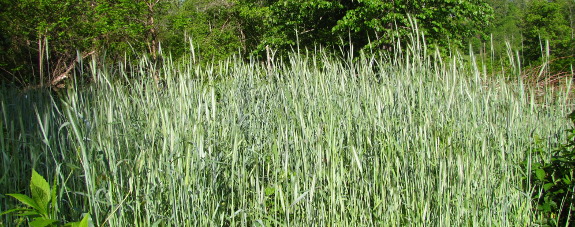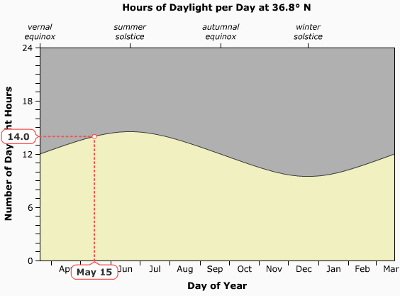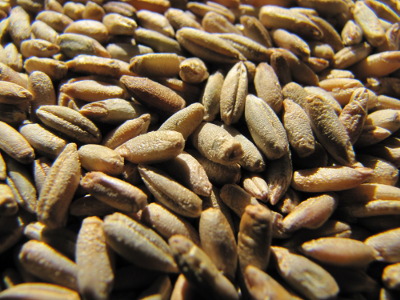
Rye as a no-till cover crop

Another year, another
experimental cover crop. This time around, I'm trying rye
(different from the ryegrass I tested out this spring) in
hopes that it'll fill an empty niche in our system. Starting at
our frost free date in the spring (May 15), I use buckwheat to fill garden gaps, then
transfer over to oats
and oilseed radish
in midsummer. In past years, I've simply kill mulched beds that
come open in the fall, but this seems like a waste of growing time (and
expensive straw), especially when balmy spring days make me itch to
fill those beds with cover crops.
 Rye didn't make it onto my
radar previously because the cereal is usually killed by tilling in,
and I'm stubbornly steering clear of cover crops that won't die
easily. However, I recently read that rye is readily mow-killed
if you wait until the flowers have fully opened, an event that happens
when day length reaches 14 hours (May 14 here, according to this
handy calculator and
last year's
rye experiment).
My new scythe will make cutting what
amounts to ultra-tall grass easy.
Rye didn't make it onto my
radar previously because the cereal is usually killed by tilling in,
and I'm stubbornly steering clear of cover crops that won't die
easily. However, I recently read that rye is readily mow-killed
if you wait until the flowers have fully opened, an event that happens
when day length reaches 14 hours (May 14 here, according to this
handy calculator and
last year's
rye experiment).
My new scythe will make cutting what
amounts to ultra-tall grass easy.
Granted, you need to
wait three to four weeks after killing rye before spreading small
vegetable seeds because of rye's allelopathic properties, and even
larger seeds and transplants can suffer from lack of nitrogen if you
plant too soon after killing the cover crop and without adding extra
compost. However, I often don't plant some beds in the front
garden until late May to mid June since I like to succession-plant
summer crops, so I'm confident I can work around rye's issues.
 Potential problems with
killing the cover crop aside, rye is beloved by many farmers and is
probably the most-used cover crop in the U.S. Rye is supposed to
produce up to 10,000 pounds of dry matter per acre while outcompeting
weeds and growing in colder weather than any other cereal. I was
very happy with the amount of growth of my first rye experiment last
year, so I'm looking forward to seeing how this cover crop does in the
garden.
Potential problems with
killing the cover crop aside, rye is beloved by many farmers and is
probably the most-used cover crop in the U.S. Rye is supposed to
produce up to 10,000 pounds of dry matter per acre while outcompeting
weeds and growing in colder weather than any other cereal. I was
very happy with the amount of growth of my first rye experiment last
year, so I'm looking forward to seeing how this cover crop does in the
garden.
Want more in-depth information? Browse through our books.
Or explore more posts by date or by subject.
About us: Anna Hess and Mark Hamilton spent over a decade living self-sufficiently in the mountains of Virginia before moving north to start over from scratch in the foothills of Ohio. They've experimented with permaculture, no-till gardening, trailersteading, home-based microbusinesses and much more, writing about their adventures in both blogs and books.
Want to be notified when new comments are posted on this page? Click on the RSS button after you add a comment to subscribe to the comment feed, or simply check the box beside "email replies to me" while writing your comment.

When did you sow your rye? I've been a naughty gardener and just mowed down the weeds that were all throughout the plot that I had left fallow this year. The plan was to kill-mulch to create a couple of beds, but at the same time, I'm itching to plant something...
Overall, planting rye, just for fun, may not be my best idea ever, but maybe next year, so, how late can you sow?
Seth and Bo --- I've read various information on planting time, which is why I didn't put anything definitive in my post. You can take your pick of:
This is when I planted our rye last year, and it did great here in zone 6. Which means that, assuming Seth is the Seth I know outside Philadelphia, he should be fine planting now too.
I'm glad Bo's grandmother chimed in! My data about planting times was only for the cover crops I was sure did well with no-till, but I should have added a caveat that others can be planted later as long as you have a plan for how to kill them.
Good luck with your cover crops!